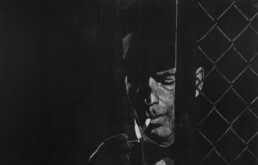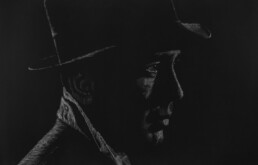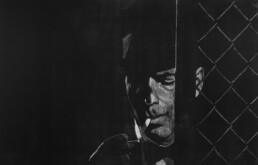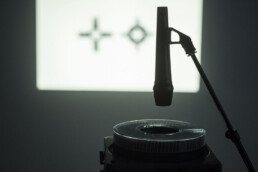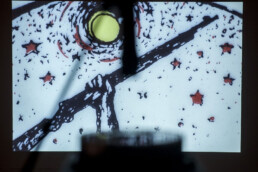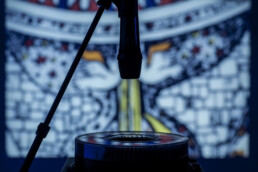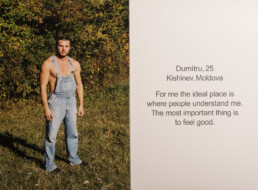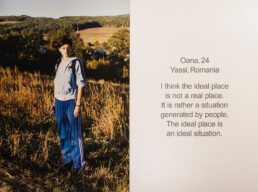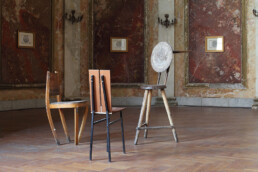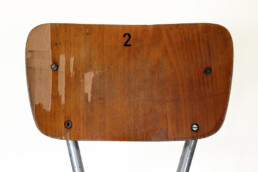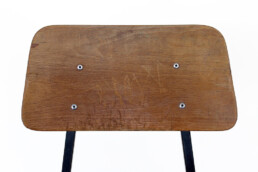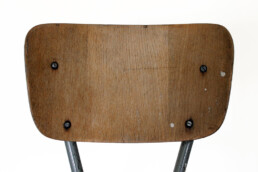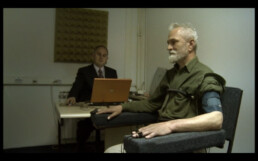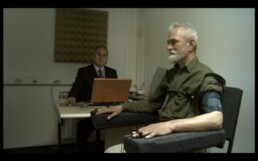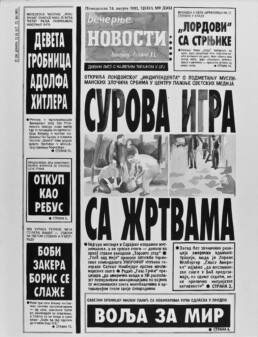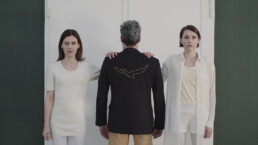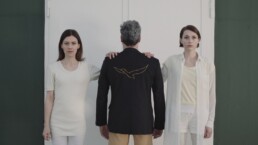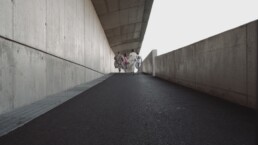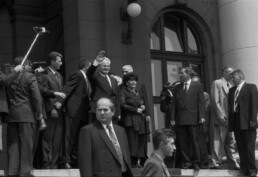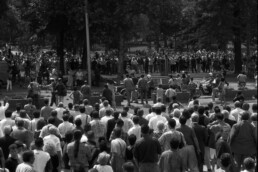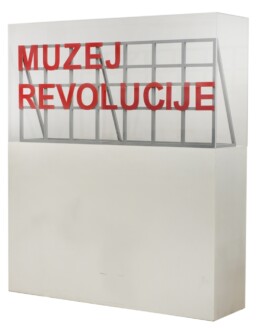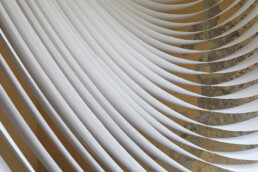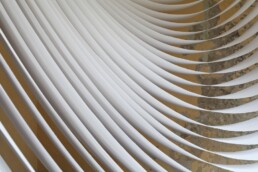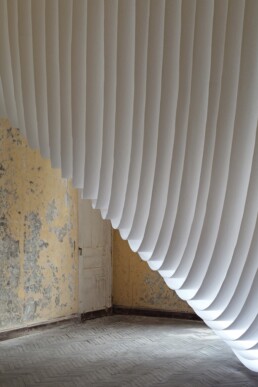Nemanja Nikolić
NEMANjA NIKOLIĆ (1987)
Double Noir, # 9, # 31, #32, #51
chalk and pastel on blackboard
120 cm x 77 cm
2016
Double Noir, # 9, # 31, #32, #51
chalk and pastel on blackboard
120 cm x 77 cm
2016
Photographs of the whole series of realized drawings are incorporated into a film animation, which thus becomes the only medium that stores the complete memory of this layered work.
With their black background, Double Noir drawings point to the aesthetics of noir films; the black background evokes the film or photographic negative, while by imprinting chalk, like by the action of light, the image is recorded on the dark surface. The drawings of frames are not direct and literal quotations taken from films. Despite the author’s realistic visual expression, his drawing is dominated by a gloomy, nightmarish atmosphere, confusing uncertainty, suspense, accompanied by dramatic contrasts and psychological tension, additionally emphasized by the minimalism of the space and ambient sound. Thematically, the Double Noir narrative develops around the legendary noir protagonist, the actor Humphrey Bogart.
Svetlana Montua, for the catalogue of the 56th October Salon
© Cultural Centre of Belgrade, the October Salon Collection and the artist
Purchase Contract: III-5-312/12.12.2017.
Inventory No. 1501
Photo: Courtesy the artist
Selected Bibliography:
56th October Salon, The Pleasure of Love. Cultural Centre of Belgrade, 2016
ABOUT THE AUTHOR:
Nemanja Nikolić (1987, Valjevo, Serbia) graduated in painting and obtained a PhD degree from the Faculty of Fine Arts in Belgrade in 2019. Since 2010 he has presented his works at solo exhibitions in the country and abroad – Art Gallery of the Cultural Centre of Belgrade; Gallery Dix9 Helene Lachermoise, Paris; Youth Centre, Belgrade; Rima Gallery, Kragujevac; U10 Art Space, Belgrade, etc. – and participated in numerous group exhibitions. Since 2018 he has worked as an assistant professor at the Faculty of Fine Arts in Belgrade. He has won several important awards, such as Drawing Award from the Vladimir Veličković Fund, Award for Mural and Wall Installation from Raiffeisen Bank and 12HUB Gallery and Award for Exceptional Creative Innovation from the Miloš Bajić Fund, A co-founder of the U10 Art Space, lives and works in Belgrade. More info at https://www.nemanjanikolic.com
Zoran Naskovski
ZORAN NASKOVSKI (1960)
Mandala and Cross / Farewell to Arms
installation (video projection, black–and-white, colour, double carousel slide projection / 2 x eighty colour slides, 2 slide projectors, 2 microphones, sound)
variable dimensions
2014
Mandala and Cross / Farewell to Arms
installation (video projection, black–and-white, colour, double carousel slide projection / 2 x eighty colour slides, 2 slide projectors, 2 microphones, sound)
variable dimensions
2014
The installation Mandala and Cross / Farewell to Arms is a series of crossed video and drawn-into-space carousel slide projections, which forms a space for a tense relationship between the scenes of empty holsters for weapons, used and discarded, and scenes of details from decorative plates, made in the Socialist Federal Republic of Yugoslavia by the Keramika Company from Bratunac, B&H. The stroboscopic method, based on the source of light that is rhythmically turned on and off, produces an intertwined sequence of the mentioned motifs. On the plates are the motifs of Yugoslav cities, painted in the form of mandalas, made in the early seventies, at the time of specific political turmoil, intensive armament and political shifts.
The installation Mandala and Cross / Farewell to Arms is part of the artist’s years-long project under the same name (Mandala and Cross), based primarily on researching, analysing and archiving of print media in real time. The connection between ornament and crime in this installation is set as a proposal for rethinking the aesthetic-political interaction characteristic of violence generated by ideologies, for rethinking what we recognize as strongly “branded” distortions, which now – through images of humanism and violence – have become an integral part of a universal process of “normalization”, which erases its conflicting origin.
© Cultural Centre of Belgrade, the October Salon Collection and the artist
Purchase Contract: III-5-158/25.5.2016.
Inventory No. 1476
Photo: Courtesy the artist
Selected Bibliography:
Branislav Dimitrijević, “Zoran Naskovski: Mandala i krst / Zbogom oružje”, text for the exhibition, Nov. 25 – Dec. 1, 2014, Centre for Cultural Decontamination (CZKD), Belgrade, 2014, https://www.czkd.org/2014/11/follow-up-mandala-i-krst-zbogom-oruzje-zoran-naskovski/, accessed on Mar. 30, 2020
Branislav Dimitrijević, “Zoran Naskovski: Mandala i krst / Zbogom oružje”, BETON – kulturno propagandni komplet, No. 207, Year XIII, Belgrade, Tuesday, May 21, 2019, 4, https://www.elektrobeton.net/strafta/zoran-naskovski-mandala-i-krst-zbogom-oruzje/, accessed on Mar. 30, 2020
ABOUT THE AUTHOR:
Zoran Naskovski (1960, Izbište, Serbia) obtained his master’s degree from the Faculty of Fine Arts, University of Arts in Belgrade. He works in a wide range of media such as video, film, performance, installation, photography and internet projects. In his critical practices, he deals mainly with the topics of political and economic violence, media manipulations, policies of global circulation of images and migrations, institutional criticism, including critical writing about the Serbian national cultural policy. Naskovski has participated in numerous international exhibitions at important museums and institutions, including Whitney Museum in New York, Andy Warhol Museum in Pittsburgh, Berkeley Art Museum and Pacific Film Archive in Berkeley, Tate Britain in London, Fridericianum Kassel in Kassel, Neuer Berliner Kunstverein in Berlin. He participated in the central exhibition of the 52nd Venice Biennale Think with the Senses – Feel with the Mind. Art in the Present Tense in 2007. He received the Nadežda Petrović Memorial Award in 1996, the Award of the Annual Exhibition of the Centre for Contemporary Art Belgrade in 1997, the Award of the 44th October Salon in 2003 and the 47th October Salon in 2006.
Paula Muhr
PAULA MUHR (1977)
Ideal Place
lambda print
50 cm х 75 cm (10 pcs)
edition: 1/5 + 2 a.c.
2003–2005
Ideal Place
lambda print
50 cm х 75 cm (10 pcs)
edition: 1/5 + 2 a.c.
2003–2005
Ideal Place is a project that deals with a utopian construction of an idyllic state of happiness. It is based on a series of interviews with young people living in different Eastern European countries. The work was exhibited at the 45th October Salon in 2004.
In almost all Eastern European countries, socialism reigned for a long time, and in most texts on utopias, it is presented in as an ideal system. The young people with whom the author spoke live in the post-communist era, in the period of globalization, while their countries are undergoing great political and economic changes, and the memory of the systems from the past remains problematic.
A utopia is always based on the principle of equality of its inhabitants, and individual desires and dreams are suppressed for the sake of the common good. Instead of applying global theories, the author stopped ordinary people on the street and asked them what their personal idea of an ideal place was.
To avoid any immediate social context, people were photographed in nature. They listed their name, age, place and country in which they live, and then described their imagined ideal place in a few sentences. This project compares different projections of utopia based on personal experience and personal wishes of young people from Eastern Europe in the early 2000s.
© Cultural Centre of Belgrade, October Salon Collection and the artist
Gift Contract: III-5-292/26.9.2014.
Inventory No. 1360
Photo: Cultural Centre of Belgrade
ABOUT THE AUTHOR:
Paula Muhr Miklošević (1977, Subotica, Serbia). She graduated in photography at the BK University in Belgrade, and received her master’s degree from the Faculty of Applied Arts in Belgrade. She has attended doctoral studies at Humboldt University in Berlin, Art and Visual History Department; a laureate of the FEX Award in Dortmund and Mangelos Award in Belgrade. In the period from 2011 to 2014, she taught at the Department of Visual Studies and Photography at the Brand Academy in Hamburg. Lives and works in Berlin. More information at www.paulamuhr.de
Milorad Mladenović
MILORAD MLADENOVIĆ (1966)
Untitled (School Chairs)
photo installation
40 cm x 60 cm (12 psc)
2014
Untitled (School Chairs)
photo installation
40 cm x 60 cm (12 psc)
2014
The Untitled (School Chairs) series of photographs show a range of chair backs, uniform and different at the same time, used and partially written off from the faculty (school) inventory. The work records the impact of use, human interventions and time on inventory property used for educational purposes.
Milorad Mladenović won the 55th October Salon Award (2014) for the Untitled (School Chairs) Series.
The artist photographed ephemeral objects from the domain of production and consumption of knowledge on which various effects of use are visible, from touching of human bodies (backs) to damage by using or moving. Repairmen’s interventions that extended the duration of the objects can also be noticed. The photographs of the objects from the local environment in which the author plays a role in the production and consumption of knowledge are life-size.
In the Untitled (School Chairs) Series, the chosen elements are specific and there is no attempt to indicate a more definite meaning from them as a whole, but to form a visible wide-frame scheme that can be understood from the context. Also, the work is designed as a possible reflection of any private or public environment. The basic classification may relate to private, work and public space of the artist’s observation.
© Cultural Centre of Belgrade, the October Salon Collection and the artist
Purchase Contract: III-5-168/1.6.2016.
Inventory No. 1424
Photo: Courtesy the artist
Selected Bibliography:
55th October Salon, Disappearing Things. Cultural Centre of Belgrade, 2014
Milorad Mladenović: Neposredni konteksti, Nov. 17 – Dec. 11, 2016, catalogue of the solo exhibition, Art Gallery, Cultural Centre of Belgrade, 2016
ABOUT THE AUTHOR:
Milorad Mladenović (1966, Belgrade, Serbia) graduated and obtained a master’s degree from the Faculty of Fine Arts in Belgrade and graduated from the Faculty of Architecture, University of Belgrade, where he has worked as an associate professor since 1995. His fields of activity are visual arts and architecture. He has participated in a great number of exhibitions in these fields in the country and abroad and been awarded several times for his work. He won three awards at the October Salons in Belgrade (2000, 2003 and 2014), the Main Award of the Nadežda Petrović Memorial in Čačak (2000) and other important awards for visual arts and architecture. His works were exhibited at Secession in Vienna (2004), Museum of Contemporary Art in Belgrade (2005 and 2012), 10th Venice Architecture Biennale (2006), etc. He occasionally publishes articles on visual arts and architecture.
Mladen Miljanović
MLADEN MILjANOVIĆ (1981)
Do You Intend to Lie to Me?
film
14’
edition: 5 + 2 a.c.
2011
Do You Intend to Lie to Me?
film
14’
edition: 5 + 2 a.c.
2011
The film shows the arresting and interrogation of Veso Sovilj: a professor at the Art Academy in Banja Luka. It’s only in the last scene of the film, when the artist enters the interrogation room, that the protagonist finds out that it is a simulation and performance by which his student Mladen Miljanović wanted to mark the thirtieth anniversary of his professor’s work. To make the action as realistic as possible, the artist engaged members of the Republic of Srpska Special Police.
The work was shown at the 52nd October Salon It’s Time We Met Each Other.
(…) To make the film Do You Intend to Lie to Me?, Miljanović used certain tactics to push the viewer into the world of brutal reality. Members of a special police unit stormed a cafe, arrested a man and escorted him to a police station in handcuffs, and helicopters monitored the entire operation from above. An interrogation ensues. Details of the suspect’s life are revealed with 26 questions. The audience feel as if they are standing on the other side of the one-way mirror in the interrogation room. They can hear the suspect’s replies, and are offered a brief look at the lie detector results.
The suspect is Veso Sovilj: an artist and a professor at the Art Academy in Banja Luka. He is the young artist’s mentor. Miljanović recorded a simulation of Sovilj’s arrest and interrogation. To make the scenes in the film as realistic as possible, Miljanović decided to work with professionals – he cooperated with members of the Republic of Srpska Special Police. The artist’s professor was not informed about the project, nor was he aware that he would have a role in a film, the leading role. After the filming was completed, Miljanović entered the interrogation room and explained that the purpose of the project was to mark the 30 years of his mentor’s artistic work. Upon hearing Miljanović’s explanation, Sovilj was thrilled.
The socio-political context of post-war Bosnian society, the consequences of wars that manifest themselves on the daily political scene, ethical and religious division and social instability are a constant in Miljanović’s art projects, performances, video works, installations. The film not only talks about the schizophrenic position of an individual within a post-war-torn state like Bosnia and Herzegovina, it also brutally metaphorically speaks about ignoring a man who devoted thirty years of his life to art by the state machinery.
Taken from the catalogue of the 52nd October Salon
© Cultural Centre of Belgrade, the October Salon Collection and the artist
Gift Contract: III-5-245/28.8.2014.
Inventory No. 1343
Photo: still from the film
Selected Bibliography:
52nd October Salon, It’s Time We Met Each Other. Cultural Centre of Belgrade, 2011
ABOUT THE AUTHOR:
Mladen Miljanović (1981, Zenica, Yugoslavia) attended the Officer Military School in Banja Luka. He graduated from the Academy of Arts in Banja Luka. Currently, he teaches New Media Art at the Academy of Arts in Banja Luka.
He represented Bosnia and Herzegovina at the 55th Venice Biennale. With his conceptual and provocative approach, he questions his own surroundings and living conditions. His work is influenced by the experience of growing up in the conditions during and after the war in the Former Yugoslavia and by his formal education obtained in the Officer Military School. More information at www.mladenmiljanovic.com
Vladimir Miladinović
VLADIMIR MILADINOVIĆ (1981)
Personal/Political
Rendered History Series
indian ink wash on watercolour paper
50.8 x 66 cm (7 psc)
2012–2013
Personal/Political
Rendered History Series
indian ink wash on watercolour paper
50.8 x 66 cm (7 psc)
2012–2013
These two drawings are part of the series for which Vladimir Miladinović was awarded at the 53rd October Salon – by the jury composed of Sarah Arrhenius, Magdalena Ziółkowska and Nikola Dedić.
The Collection includes seven drawings showing headlines such as: Officially – Assembly Centres, Towards Prisoners by World Standards, Imprisoned Serbs, Auch Im Vātikan Diskussion über militarische Aktion in Bosnien, Jugo-Generäle als Kriegsverbrecher von Gericht, Contract Massacre, A Cruel Play with Victims
Since 2012, Vladimir Miladinović has been following his daily routine in which he is devoted to archival research in the tabooed historical periods about which it is difficult to reach a broader social consensus.
By transferring, i.e., faithfully copying the collected material into the form of drawings, in the technique of ink wash, the artist makes a series of works through which he tries to establish a personal relation to the offered material. The works in this series are a kind of cathartic recollection, through which each viewer goes while reading the pages and articles – in the beginning only from Serbian newspapers of 1991 and 1992 – and compare them with their own inscribed knowledge of the events during the period of war in the territory of the former Yugoslavia, taken as the subject of the work.
In the later years, the research included the archive of articles about the same period from newspapers in Austria, Croatia, Spain and Ireland. The works, among other things, show some of the ways in which the dominant ideologies at a given moment carry out the process of ideological interpellation.
“The drawings were created as a result of a year-long research of the archival material kept at the National Library of Serbia in Belgrade. The subject of the research was the daily press from the early 1990s. Particular attention was paid to texts related to the war in Croatia and Bosnia and Herzegovina. These were daily newspapers from the territory of Serbia: Politika, Večernje novosti, Politika ekspres and Borba. Emphasis was placed on two historical periods, November 1991 and August 1992. These two periods are two important neuralgic points for the context of contemporary Serbia, when talking about the war on the territory of the former Yugoslavia. Both periods, viewed from the perspective of writing of the local press, give us a broader picture of what was happening in the recent past of Serbia and how, and these are also current issues in the new Serbian society. The current policies of remembrance of that period, the dominant narratives created today about these events, bring to the fore the question of personal responsibility, that is, how we will now relate to what is part of the public sphere of the society in which we live.”
Vladimir Miladinović, from the catalogue of the 53rd October Salon
© Cultural Centre of Belgrade, October Salon Collection and the artist
Gift Contract: III-15-44/20.3.2014. (4 pcs)
Inventory No. 1341
Purchase Contract: III-5-477/1/15.12.2014. (3 pcs)
Inventory No. 1382
Photo: Courtesy of the artist
Selected Bibliography:
53rd October Salon, Good Life: Physical Narratives and Spatial Imaginations. Cultural Centre of Belgrade, 2012
ABOUT THE AUTHOR:
Vladimir Miladinović (1981, Belgrade, Serbia) graduated from the Faculty of Applied Arts in Belgrade and completed his doctoral courses in interdisciplinary studies at the University of Arts in Belgrade. He was a member of the art/theory group “Four Faces of Omarska”, dealing with the questioning of memorial strategies in the territory of the former Yugoslavia. His work is focused mainly on reviewing the politics of memory, media manipulation, as well as the creation and interpretation of historical narratives. More information at http://vladimirmiladinovic.blogspot.com
Anuk Jovović (Miladinović)
ANUK JOVOVIĆ (MILADINOVIĆ) (1984)
Parting, Dedicated to RM
HD video
7’ 31”, loop
2015
Parting, Dedicated to RM
HD video
7’ 31”, loop
2015
The work was exhibited at the 56th October Salon, The Pleasure of Love.
Parting, Dedicated to RM shows a group of four people in a landscape around the Rhine in Basel (Switzerland), where RM lived the second part of his life and died in the autumn of 2014. Different segments of the work suggest a series of interconnections in the relationships among these four persons, as well as a ritual related to one of them and the act of his departure.
The scenes were shot from five static camera positions. They are repeated several times during the video, emptied or with small differences in activities of the persons.
Cast: Jörg Besser, Heidi Feldmann, Bernhard Gilgen, Linnéa Schwarz
© Cultural Centre of Belgrade, October Salon Collection and the artist
Gift Contract III-5-86/7.4.2017.
Inventory No. 106
Photo: still from the video work
ABOUT THE AUTHOR:
Anuk Jovović (Miladinović) (1984, Brussels, Belgium) lives and works in Munich and Basel. She completed her undergraduate and master’s studies at the Faculty of Fine Arts in Munich (2005-2012). In her video works, she often explores the relationship between human beings and their environment, creating abstract narratives in which there is no hierarchy between the characters and the scenography. She has won numerous awards, including the Vkunst Media Award in Frankfurt, the Baustelle Schaustelle Art Award in Essen, the Bavarian Government Debut Award, the Project Award given by the Irwin and Gisele von Steiner Foundation, etc. More information at www.anukmiladinovic.com
Goranka Matić
GORANKA MATIĆ (1949)
Shop Windows Belgrade 1980, Belgrade 1999, Belgrade 2008
colour photographs
30 cm x 40 cm (3 pcs)
2008
Photo Essays
video
15′
2021
Shop Windows Belgrade 1980, Belgrade 1999, Belgrade 2008
colour photographs
30 cm x 40 cm (3 pcs)
2008
The work was exhibited at the 49th October Salon in 2008; it consists of photographs of the shop windows taken on the day of Josip Broz Tito’s death, then during the NATO bombing of Belgrade and after Kosovo’s declaration of independence.
It is a selection of photographs in which the protagonist of the photographic event is the Belgrade Shop Window. The first series was made in May 1980, during the national mourning days for the death of Yugoslav President Josip Broz Tito, Days of Pain and Pride, as the local press called them. The second series was made during the NATO bombing of Belgrade, in the spring of 1999. The third series was taken on February 21, 2008, and records the situation in the Serbian capital after Kosovo’s declaration of independence on February 17.
As in many of her other works (which are usually conceived as series), her knowledge of art history and photography can be detected in this one, too: I think that the historical references for these three series with shop windows would be dada and European surrealism, and of course Walter Benjamin’s writings. For all of them, as well as for the author herself, the shop window is a place, more precisely a sign, of the consumer society. Unlike her predecessors, however, Goranka Matić shows us shop windows in the local context (Titoism, war, i.e., the period of transitional economy) and thus points to the unbreakable relations between two different ideologies, the commodity and the political, be it socialist or nationalist. At the same time, these three series can be perceived as three historical stations in the life of Belgrade.
Bojana Pejić, from the exhibition catalogue of the 49th October Salon
© Cultural Centre of Belgrade, October Salon Collection and the artist
Gift Contract: III-5-328/24.08.2018.
Inventory No. 112
Photo: Courtesy of the artist
Photo Essays
video
15′
2021
This is the latest work by Goranka Matić, a series of digitalised photo essays turned into a video work, testifying to the recent historical events.
The photo documents transformed into video essays are permeated with the images of the city, of the events that now already belong to history, of life and the author’s intimate world. Goranka’s greatest interest is in life, so the truthfulness of her photo recordings inspires pain and respect at the same time. The principle of honesty and the power to be present and empathic on the one hand, while on the other impartial and reserved to just the right extent, have made her one of the most significant visual artists from this part of the world. The photo essays record the events on the streets of Belgrade in March 1991, Slobodan Milošević’s appointment as President of the Republic of Serbia, a journey by Trans-Siberian Railway, women crossing borders, and memorabilia of the author’s life.
© Cultural Centre of Belgrade, October Salon Collection and the artist
Purchase contract: III-5-279/08.10.2021.
Inventory No.
Photo: video frame, courtesy of the artist
ABOUT THE AUTHOR:
Goranka Matić (1949, Maribor, Slovenia) lives and works in Belgrade. She graduated in art history from the Faculty of Philosophy in Belgrade. She took up photography in 1980 and has published her works in the magazines Džuboks, Start, Svijet, Polet, Omladinske novine, Duga, Liberation, Delo, Politika. Since its foundation in 1971, she has been collaborating with the Student Cultural Centre (SKC) and was one of the editors of the art program and curator of its Happy New Art Gallery. From 1978 to 1980, she ran the 45 Gallery in Novi Beograd. In the 1980s, she became involved in rock photography and made numerous record covers for some of the most famous rock bands in this region.
She was the editor of photography in the weekly Vreme and the daily Politika, and in 2010 she started working at the Radio Television of Serbia – Art Directorate.
She taught photojournalism at the Faculty of Political Sciences in Belgrade for eight years; a member of ULUPUDS since 1986; exhibited in the country and abroad and received the 39th October Salon Award, the Osvajanje slobode [Conquering Freedom] Award in 2002, the Politika Award in 2004 and the annual ULUPUDS Award in 2005; published the books Days of Pain and Pride and Ten Years Against; the Association of Journalists of Serbia awarded Goranka Matić with the Lifetime Achievement Award in 2019. She is an assistant professor at the Department of Digital Arts at the Faculty of Media and Communications. Her works are part of the collection of the Museum of Contemporary Art in Belgrade
Marko Lulić
MARKO LULIĆ (1972)
Museum of Revolution
wood, acrylic on glass
160 cm x 70 cm x 40 cm
2009–2014
Museum of Revolution
wood, acrylic on glass
160 cm x 70 cm x 40 cm
2009–2014
Lulić’s oeuvre is based on exploring of strategies for deconstructing the concepts of the legacy of modernism in Eastern and Western Europe, monuments, architecture, issues of collective memory, and historical, economic and social aspects of art. Many of his works are related to Yugoslav modernism, an authentic post-war phenomenon, an amalgam of the Western Bloc modernism and Eastern European communism. He looks into the selected topics and objects from a certain distance and with a touch of irony, without reviving the current political demands originally loaded into them. Using various media (sculpture, video, performance, photography), Lulić critically re-examines the relations of form and ideology, deconstructs, re-contextualizes and re-conceptualizes, giving new meanings to objects and spaces.
Lulić’s Museum of Revolution was originally designed as a work of monumental dimensions intended for a public space. In 2010 the inscription in red metal letters, inspired by the aestheticism of American billboards, was temporarily installed on the roof of the concrete extension of the Belvedere Museum in Vienna. The starting point for the work was the initiative for establishing and building the Museum of Revolution in Belgrade in the early 1960s, whose realization remained at the construction of its foundations, near the Museum of Contemporary Art. With this work, Lulić questions the meanings of the concepts “museum” and “revolution” – what the nature of a museum of revolution as an institution should be if we presume that the idea of the museum classification and presentation of a revolution is paradoxical, taking into account the fact that it is through revolution that institutional and social frameworks are re-examined; what a museum is today, what it should be like and what its role in society is. For the artist, this unrealized museum is a good example of how manifestos of a revolution can turn into symbols of decline. The work in the October Salon Collection is identical in form, while it differs in material and is intended for exhibiting in an inside (institutional) space, thus itself becoming a museum / gallery exhibit, highlighting the previously open questions without pretensions to provide definitive answers and leaving room for different interpretations. The work was exhibited at the 55th October Salon.
© Cultural Centre of Belgrade, the October Salon Collection and the artist
Gift Contract: III-5-294/1/29.9.2014.
Inventory No. 043
Photo: Milan Kralj
Selected Bibliography:
Marko Lulić – FUTUROLOGY. Exhibition Jun. 30 – Sept.10, 2017, Lentos Kunstmuseum Linz, Vfmk Verlag für moderne Kunst GmbH, Vienna, 2017
Marko Lulić – o. T. (Lichtung) / Untitled (Clearing). 2010 was realized for sculpture project kunstwegen raumsichten. Publication: edition kunstwegen Städtische Galerie Nordhorn, Vienna, 2012
Marko Lulić DEATH OF THE MONUMENT. Dieser Katalog erscheint anlässlich der Ausstellung Marko Lulić New Works, Kunststiftung Erich Hauser, Oct. 10 – Nov. 1, 2009, Rottweil SCHLEBRÜGGE.EDITOR, Vienna, 2009
ABOUT THE AUTHOR:
Marko Lulić (1972, Vienna, Austria) studied at the University of Applied Arts and the Academy of Fine Arts in Vienna, where he also taught from 2008 to 2014. He has won a number of awards and participated in residency programmes in Europe and America. He has exhibited at numerous group and solo exhibitions at key international art institutions, museums and galleries (Austria, Norway, USA, Croatia, Serbia, Poland, Germany, South Korea, Sao Paolo, Greece, France, the Netherlands, Italy, England…). He currently teaches at the Faculty of Architecture and Spatial Planning of the Vienna Technical University.
Ana Krstić
ANA KRSTIĆ (1978)
We Don’t Know What It Is, But It Is Certainly Not What You Think It Is
sculpture, metal, calico linen
420 x 320 x 400 cm
2012
We Don’t Know What It Is, But It Is Certainly Not What You Think It Is
sculpture, metal, calico linen
420 x 320 x 400 cm
2012
We don’t know what this is but certainly it is not what you think it is by Ana Krstić may be regarded as a soft sculpture. It is soft not only because it is made of canvas strips that can be rearranged and reinstalled in different shapes; it is soft also in its ability to blend into a space and to adapt to its conditions, its smells, its colours and its stories. Yet this softness is interfering, it is on the way, and it cannot be grasped “at one go” and comprehended in any sense of wholeness from any fixed viewpoint. Partly a reference to “vorlehre” exercises with paper and scissors at Bauhaus, partly a reference to 1960s minimalism, this piece as crammed in an abandoned mouldy office is not what you think it is, and it is not what you expect it should be. – Branislav Dimitrijević, from the catalogue of the 53rd October salon, page 56.
The work was produced and exhibited at the 53rd October Salon: Good Life, 2012
© Cultural Centre of Belgrade, October Salon Collection and the artist
Purchase Contract: III-5-454/1/10.12.2014.
Inventory No. 1381
Photo: installation view 53rd October Salon, Ana Kostić
Selected Bibliography:
53rd October Salon, Good Life: Physical Narratives and Spatial Imaginations. Cultural Centre of Belgrade, 2012
Art + Media, Journal of Art and Media Studies, No 7, April 2015, Art and Politics: Agency, Autonomy, Emancipation – Artist Portfolio, Singidunum University, Belgrade, 2015, 78–81.
Vesna Milosavljević, “Možemo li sada stati?” (talk with the artist), SEEcult.org, Belgrade, July 22, 2012, http://www.seecult.org/vest/mozemo-li-sada-stati, accessed on March 27, 2020
Guided tour of the exhibition We Can’t Stop Now, SEEcult.org, 2012, https://www.youtube.com/watch?v=j3-tWdeD0Fk, accessed on March 27, 2020
ABOUT THE AUTHOR:
Ana Krstić (1978, Valjevo, Serbia) is a visual artist working in diverse media (sculpture, installation, video) and cultural worker working within different institutional and non-institutional contexts. In her practice since 2010 she specializes in site-specific and participatory projects with focus on memorial culture and appropriation of public space. She approaches these topics from a clear feminist perspective. From 2010 to 2014 she worked as a program manager in a cultural center in her hometown Mionica. Since 2014 she is based in Berlin. More information at https://anakrstic.wordpress.com and @anna.krstiic
